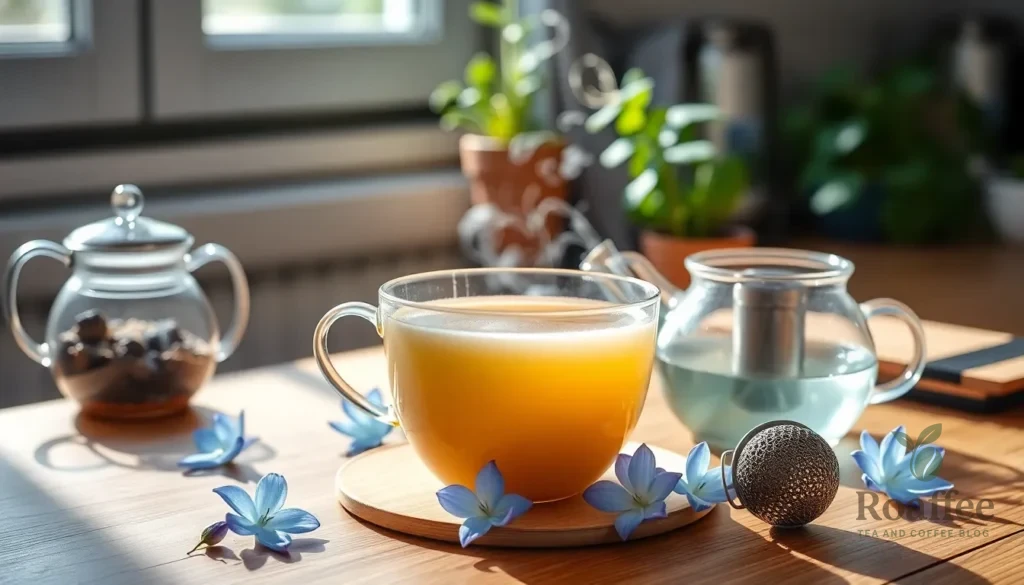We’ve discovered one of nature’s most enchanting beverages – blue lotus tea. This mystical flower has captivated civilizations for thousands of years, from ancient Egypt where it adorned pharaohs’ tombs to modern wellness enthusiasts seeking natural relaxation. The sacred blue lotus (Nymphaea caerulea) offers a gentle, dreamy experience that’s both calming and uplifting.
What makes blue lotus tea truly special isn’t just its stunning azure petals – it’s the subtle euphoric effects that help melt away stress and promote restful sleep. We love how this caffeine-free herbal tea creates the perfect evening ritual, whether you’re winding down after a long day or preparing for meditation.
The best part? Making blue lotus tea at home is surprisingly simple, and we’re about to show you exactly how to brew this ancient elixir. You’ll learn the perfect steeping techniques, ideal water temperatures, and creative ways to enhance your blue lotus experience with complementary herbs and natural sweeteners.
What Is Blue Lotus Tea
Blue lotus tea represents one of nature’s most fascinating botanical beverages, crafted from the delicate petals and buds of the Nymphaea caerulea flower. This aquatic plant flourishes in East Africa and has captivated civilizations for over 3,000 years with its ethereal beauty and therapeutic properties.
We find that blue lotus tea offers a naturally caffeine-free alternative to traditional teas, making it perfect for evening consumption without disrupting sleep patterns. The flower itself contains various compounds including nuciferine and aporphine, which contribute to its renowned calming effects on both mind and body.
Ancient Egyptians regarded blue lotus as a sacred plant, often depicting it in tomb paintings and religious ceremonies. They believed the flower possessed mystical qualities that could induce vivid dreams and promote spiritual enlightenment. Archaeological evidence shows that Egyptians commonly brewed blue lotus petals into teas and incorporated them into wines for ceremonial purposes.
The tea presents a unique flavor profile that we describe as subtly floral with earthy undertones and a hint of natural sweetness. Unlike many herbal teas that can taste medicinal or overpowering, blue lotus tea offers a gentle, pleasant drinking experience that appeals to both novice and experienced tea enthusiasts.
Modern research suggests that blue lotus tea may support relaxation and stress relief through its natural compounds. Many people report feeling a sense of calm and tranquility after consuming the tea, particularly when enjoyed as part of an evening routine. The flower’s gentle properties make it suitable for regular consumption without the jittery effects associated with caffeinated beverages.
We appreciate that blue lotus tea serves multiple purposes beyond simple refreshment. Some individuals use it as a meditation aid, while others incorporate it into their bedtime rituals to promote restful sleep. The tea’s versatility allows for creative preparation methods, including hot brewing, cold steeping, and blending with complementary herbs like chamomile or lavender.
Health Benefits of Blue Lotus Tea
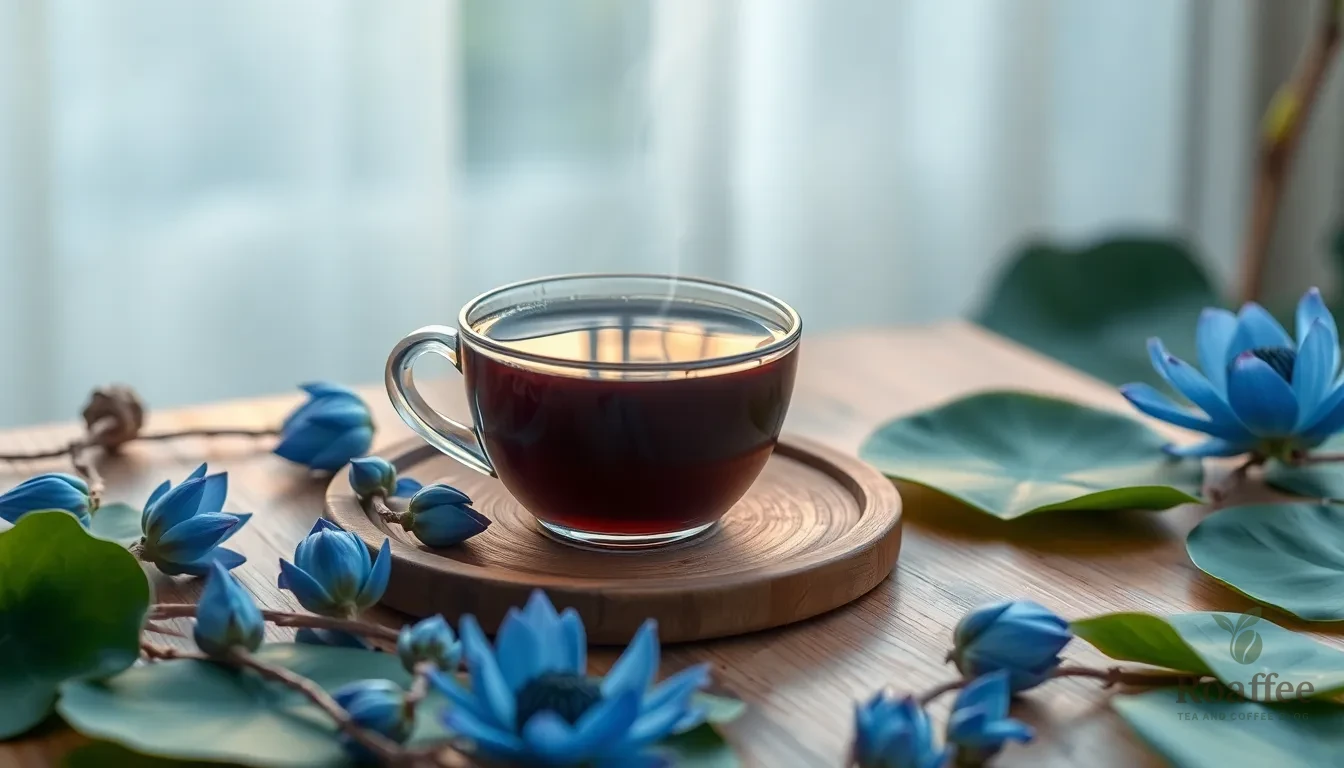
We find that blue lotus tea offers remarkable wellness benefits that make it far more than just a pleasant evening beverage. The tea’s natural compounds work synergistically to support both physical and mental well-being in several key ways.
Stimulates Relaxation stands as one of the most notable benefits we observe when drinking blue lotus tea. The flower’s active compounds interact with our nervous system to promote a profound calming effect that helps ease tension throughout the body. This relaxation response makes the tea particularly valuable for those dealing with daily stress or anxiety.
Mood Enhancement represents another important advantage we experience with regular consumption. Blue lotus tea functions as a natural mood elevator that can help reduce stress levels and promote emotional balance. Many users report feeling more centered and peaceful after incorporating this tea into their wellness routine.
Sleep Aid properties make blue lotus tea an excellent choice for our evening rituals. The tea may assist in improving sleep quality by naturally preparing the body for rest without the harsh effects of synthetic sleep aids. Its caffeine-free nature ensures we can enjoy it close to bedtime without disrupting our natural sleep patterns.
Antioxidant Properties provide essential protection against oxidative stress and inflammation throughout our bodies. These powerful compounds help neutralize harmful free radicals that can damage cells and contribute to various health issues. The rich antioxidant content supports overall cellular health and may contribute to longevity.
Digestive Health benefits emerge from the tea’s ability to relax the digestive tract and reduce discomfort. We notice that blue lotus tea can help soothe digestive issues and promote better gastrointestinal function when consumed regularly. This gentle support makes it an ideal choice for those with sensitive digestive systems.
Cognitive Support occurs through the tea’s antioxidant compounds that may protect neurons from oxidative stress. This neuroprotective effect potentially supports brain health and cognitive function over time. Regular consumption may help maintain mental clarity and focus as we age.
Ingredients
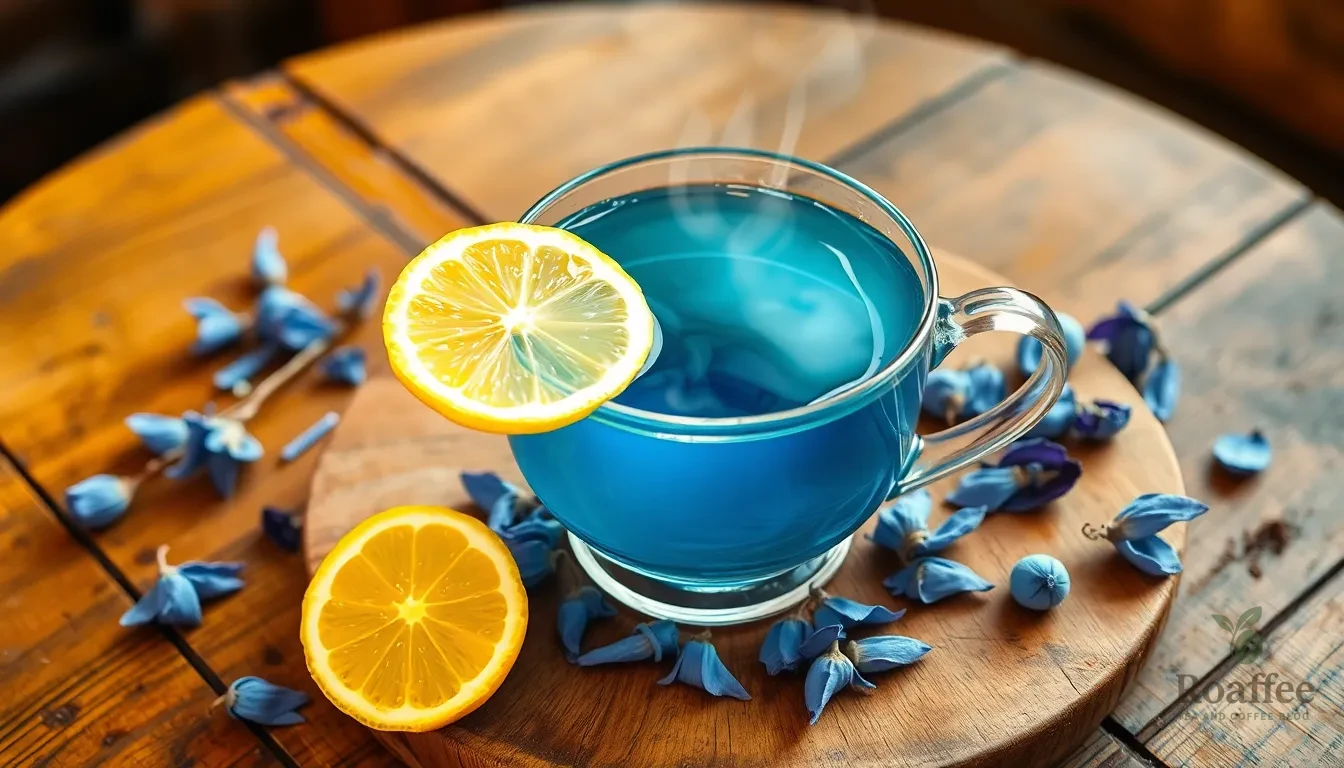
Creating the perfect cup of blue lotus tea requires just a few simple ingredients that we can easily source and prepare at home. The beauty of this ancient beverage lies in its simplicity and the flexibility it offers for customization according to our taste preferences.
Essential Ingredients
For our basic blue lotus tea recipe, we need:
- Fresh, clean water (250-500 ml)
- Dried blue lotus flowers or blue lotus tea bags (2 tablespoons if using loose flowers)
- Honey or sugar (optional, for sweetness)
Water Requirements
We recommend using filtered or spring water to ensure the purest taste in our blue lotus tea. The water quantity depends on our desired strength preference:
| Water Amount | Brew Strength | Best For |
|---|---|---|
| 250 ml | Stronger flavor | Experienced blue lotus tea drinkers |
| 500 ml | Lighter brew | First-time users or mild taste preference |
Flower Selection
Our dried blue lotus flowers should be sourced from reputable suppliers to ensure quality and potency. We look for flowers that maintain their deep blue color and possess a subtle, pleasant aroma. Tea bags offer convenience for those who prefer a mess-free brewing experience.
Optional Sweeteners
Natural sweeteners enhance the floral notes of our blue lotus tea without overwhelming its delicate flavor profile. Honey complements the tea’s natural sweetness while adding its own therapeutic properties. Raw sugar provides a clean sweetening option that dissolves easily in hot water.
Blend Enhancement Ingredients
For our specialty variations, we can incorporate additional ingredients:
- Chamomile flowers (1 tablespoon for relaxation blend)
- Green tea leaves (1 tablespoon for antioxidant boost)
- Cinnamon stick (1 piece for chai variation)
- Cardamom pods (2-3 pods for spiced blend)
- Fresh ginger root (1 inch piece, sliced)
- Fresh lemon (1 wedge for citrus notes)
These ingredients allow us to create personalized blends that cater to different moods and occasions throughout our day.
Equipment Needed
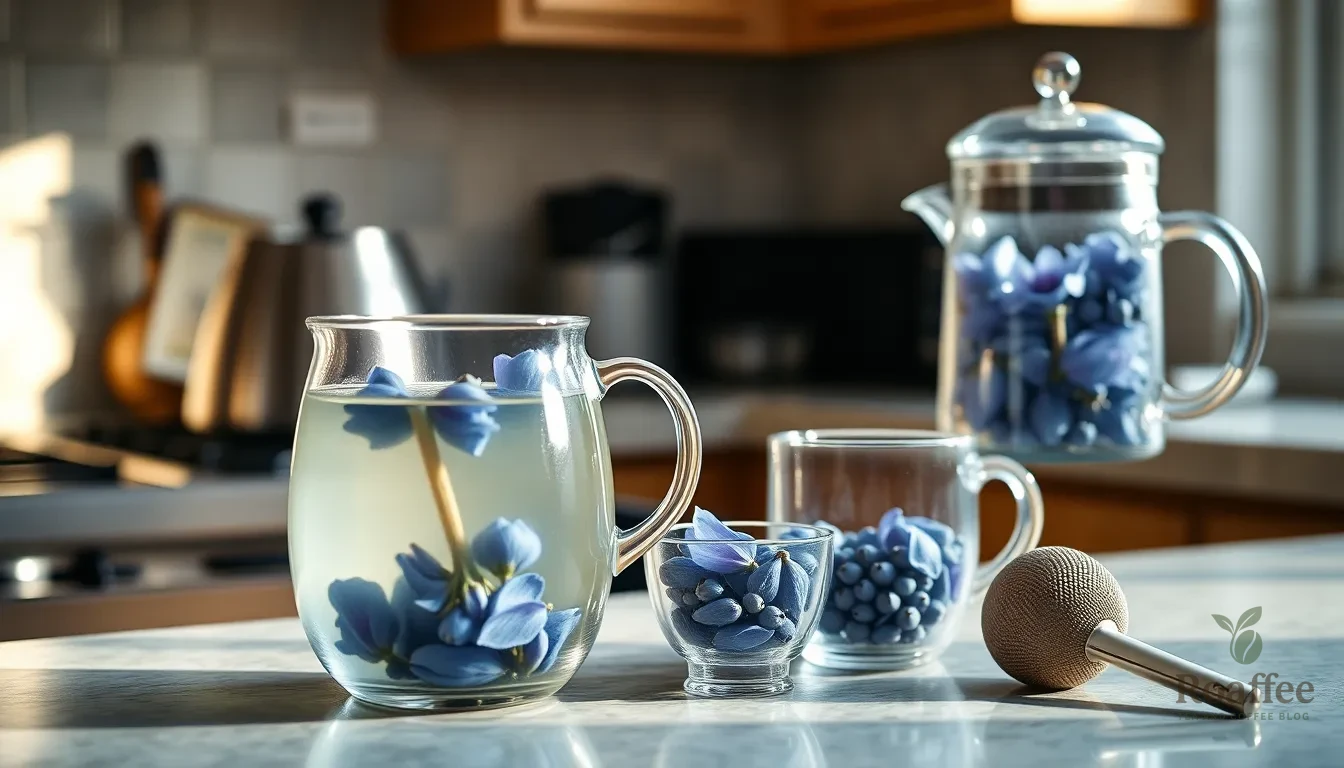
Preparing blue lotus tea requires minimal equipment that most home brewers already have in their kitchen. We recommend gathering these essential tools before beginning your tea preparation to ensure a smooth brewing process.
Essential Equipment:
- Kettle or pot for boiling water
- Teapot, mug, or jar for steeping the tea
- Tea infuser, tea ball, or fine mesh sieve to hold and strain the dried flowers
- Measuring spoons to accurately measure the blue lotus flowers
Optional Equipment:
- Lid or saucer to cover your vessel during steeping
- Thermometer to monitor water temperature for optimal extraction
- Timer to track steeping duration
The tea infuser or tea ball serves as our most important tool for loose flower preparation. We suggest choosing one with adequate space to allow the blue lotus petals to expand and release their full flavor profile. Coarsely chopped petals work best in these containers as they provide room for the flowers to “swim” during the steeping process.
For those preferring a simpler approach, a fine mesh sieve works excellently for straining the tea after steeping. This method allows the flowers complete freedom to infuse while ensuring easy removal before serving.
Our brewing vessel choice impacts the final tea quality significantly. Glass or ceramic containers preserve the delicate floral notes better than metal options. We recommend selecting a vessel that holds at least 8 ounces to accommodate proper flower expansion and water circulation.
Temperature control enhances the brewing experience considerably. Water heated to around 180°F (82°C) extracts the optimal flavor compounds without overwhelming the delicate blue lotus essence. A simple kitchen thermometer helps achieve this precise temperature consistently.
Instructions
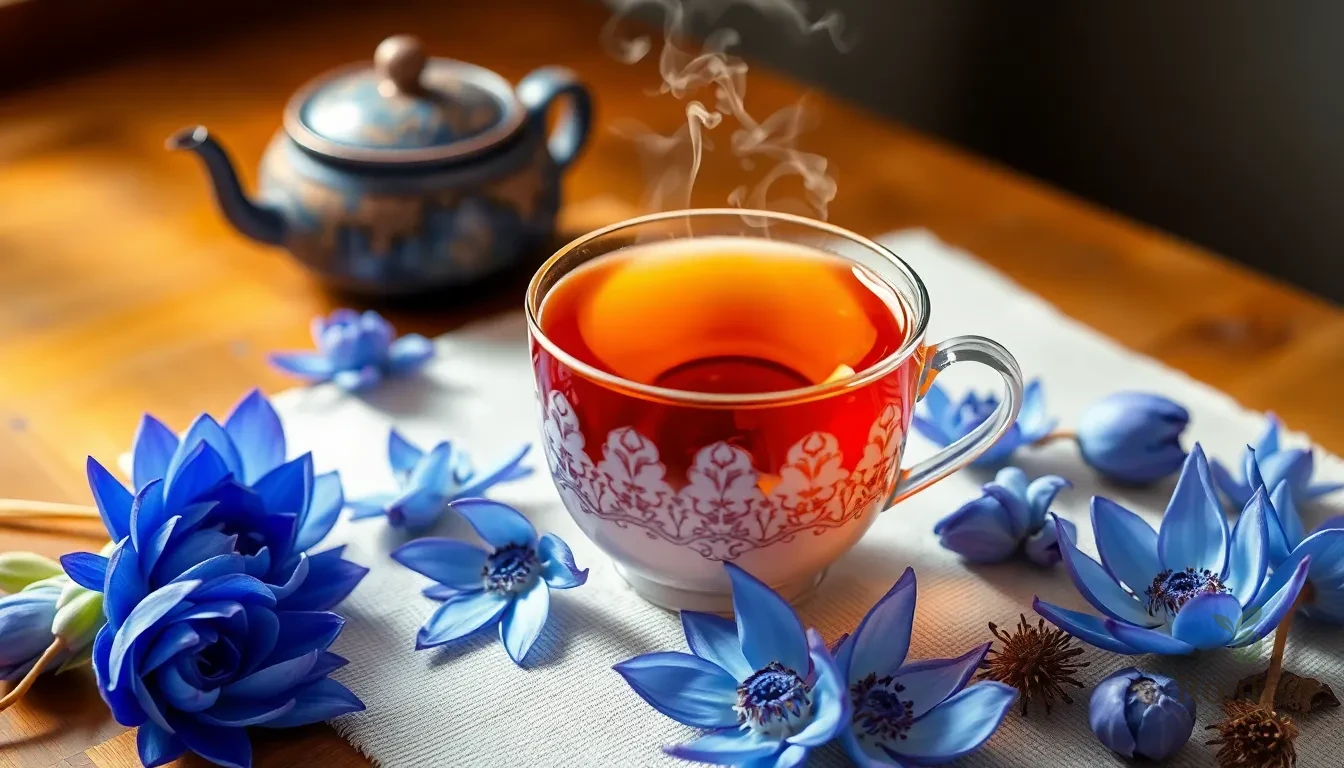
We’ll guide you through our proven four-step process for brewing the perfect cup of blue lotus tea. This straightforward method ensures you extract the maximum flavor and therapeutic benefits from your dried blue lotus flowers.
Prep the Blue Lotus
We begin by measuring out our dried blue lotus flowers carefully. Use 1-2 tablespoons or 1-2 grams for a single serving cup. The flowers should appear vibrant and aromatic when you open your container. We recommend storing dried blue lotus in an airtight container away from direct sunlight to preserve its potency. Check that your flowers are free from any debris or excessive stems before measuring.
Boil the Water
We heat 250-500 ml of fresh water to the optimal temperature of 200°F (93°C). Avoid bringing the water to a rolling boil as this can damage the delicate compounds in blue lotus and create a bitter taste. We watch for small bubbles forming on the bottom of the pot rather than large bubbling at the surface. Remove the water from heat once it reaches the proper temperature to preserve those essential volatile oils that give blue lotus its distinctive aroma and therapeutic properties.
Steep the Tea
We pour the hot water over our measured blue lotus flowers in a teapot or mug. Cover the vessel immediately to trap the heat and prevent the aromatic oils from escaping. Allow the tea to steep for 5-15 minutes depending on your preferred strength. We typically recommend starting with 5-10 minutes for your first brew to gauge the flavor intensity. Steeping longer than 15 minutes may result in excessive bitterness that masks the flower’s natural sweetness. The water should take on a beautiful amber or light golden color as the flowers release their essence.
Strain and Serve
We strain the tea through a fine mesh sieve or tea infuser to remove all flower particles. Add honey or sugar if desired to enhance the naturally sweet floral notes. Serve the tea hot while it retains its full aromatic profile. We recommend sipping slowly to appreciate the gentle floral sweetness balanced by subtle earthy undertones. The tea delivers a sensory experience reminiscent of walking through a blooming garden while providing the calming effects blue lotus is known for.
Brewing Methods
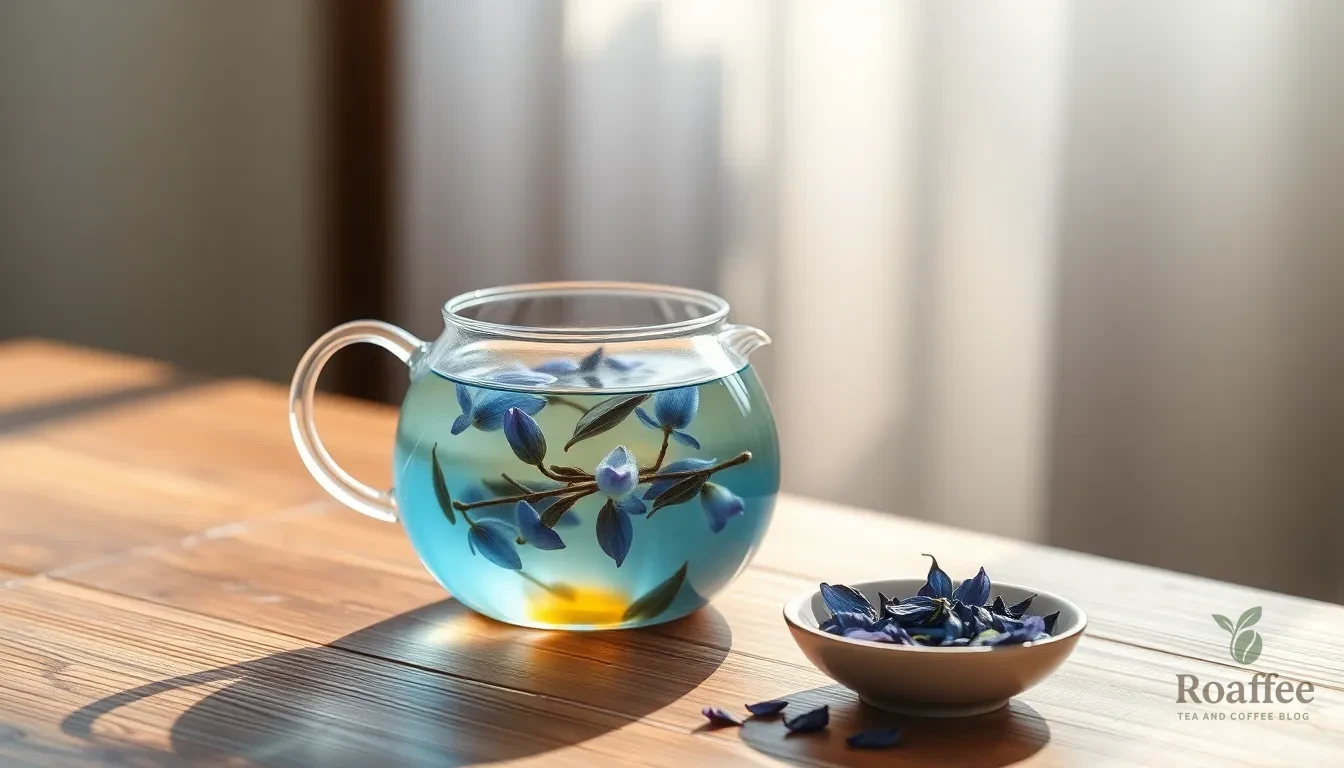
We’ll explore three distinct brewing methods that unlock different flavor profiles from your blue lotus petals. Each technique offers unique benefits and creates a distinctive tasting experience.
Hot Water Method
We recommend using 1 to 2 teaspoons of dried blue lotus petals per cup of water for this traditional approach. Heat fresh water to 180°F–200°F (82°C–93°C) rather than bringing it to a full boil, which can extract bitter compounds from the delicate petals.
Place the petals in a teapot or tea infuser and pour the heated water over them. Allow the mixture to steep for 5 to 10 minutes, adjusting the time based on your preferred strength. Longer steeping times will intensify the floral notes and earthy undertones.
Strain the petals completely before serving to prevent over-extraction. The hot water method extracts essential oils and rich aromas most effectively, delivering a warm and fragrant experience. We suggest adding honey or lemon to enhance the natural sweetness if desired.
Cold Brew Method
We place 1 teaspoon of dried petals per cup of cold filtered water for this gentle extraction method. Combine the ingredients in a pitcher or jar and refrigerate the mixture for several hours or overnight.
The extended steeping time allows the water to slowly draw out the floral compounds without heat. This process yields a smooth and delicate flavor with significantly less bitterness than hot brewing methods.
Strain the petals before serving the chilled tea. Cold brew retains the natural sweetness and floral notes of blue lotus while providing a refreshing drink perfect for warm weather. We find this method particularly appealing for those who prefer milder tea flavors.
Sun Tea Method
We combine dried petals with water in a clear glass container for this natural infusion technique. Use similar ratios as the cold brew method, typically 1 teaspoon of petals per cup of water.
Position the container in direct sunlight for 3 to 5 hours, allowing the sun’s heat to slowly infuse the tea. The gentle warming process creates a naturally balanced extraction that highlights the floral aroma without harsh notes.
Strain the petals and serve the tea chilled or over ice. Sun tea offers a mellow flavor profile that showcases the blue lotus’s natural characteristics through this ancient brewing method.
| Method | Water Temp | Amount Blue Lotus Petals | Steep Time | Flavor Profile | Serving Suggestion |
|---|---|---|---|---|---|
| Hot Water | 180–200°F (82–93°C) | 1–2 tsp per cup | 5–10 minutes | Floral, sweet, slightly earthy | Hot; honey or lemon optional |
| Cold Brew | Cold (Refrigerated) | 1 tsp per cup | Several hours to overnight | Smooth, delicate, less bitter | Chilled; pure or with sweetener |
| Sun Tea | Ambient sunlight | 1 tsp per cup | 3–5 hours in sun | Floral, mellow, naturally infused | Chilled; refreshing |
Flavor Variations
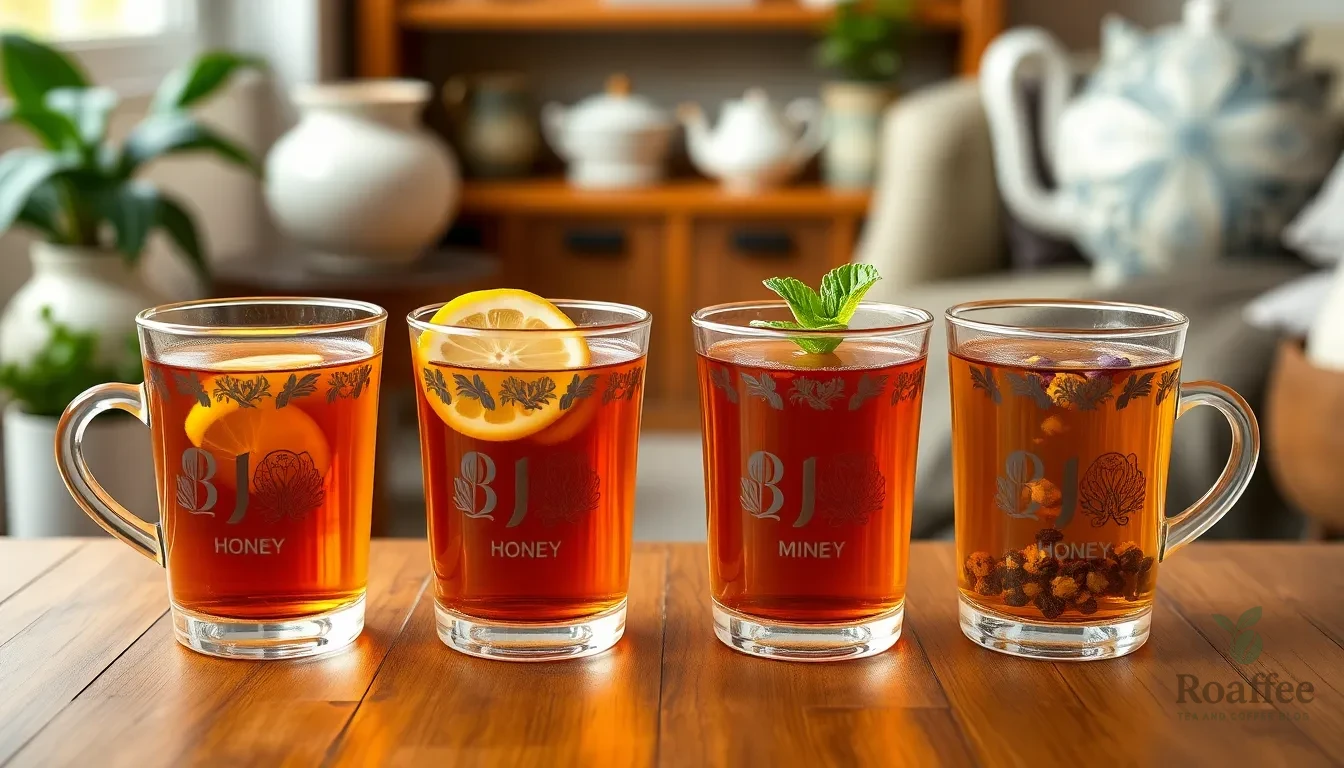
We can transform our basic blue lotus tea into exciting new flavor combinations that enhance its natural floral sweetness and calming properties. These variations allow us to customize our tea experience while maintaining the therapeutic benefits of the sacred blue lotus flower.
Blue Lotus Honey Tea
We create this soothing variation by preparing our basic blue lotus tea and adding honey to taste after steeping. The honey enhances the natural floral sweetness while adding its own soothing properties to the blend. This combination works particularly well for evening relaxation rituals since honey contains compounds that support better sleep quality. We recommend starting with 1 tablespoon of honey per cup and adjusting based on our preferred sweetness level.
Blue Lotus Lemon Tea
We prepare this refreshing variation by steeping 1 tablespoon of dried blue lotus flowers alongside 1 tablespoon of green tea leaves for 5 minutes in hot water. Fresh lemon juice gets squeezed directly into the cup before we strain out the tea leaves. This combination delivers both calming and antioxidant effects while the citrus twist adds a bright, invigorating flavor that balances the earthy undertones of the blue lotus. The vitamin C from fresh lemon also provides additional wellness benefits to complement our tea ritual.
Blue Lotus Mint Tea
We create this cooling variation by adding fresh mint leaves during the steeping process or using them as a garnish after brewing our blue lotus tea. The mint contributes a refreshing, invigorating flavor that pairs beautifully with the floral notes while supporting healthy digestion. We can use 3-4 fresh mint leaves per cup or add dried mint during the steeping process. This variation works exceptionally well as an after-meal tea since mint naturally aids digestive function.
Blue Lotus Chamomile Blend
We create this ultimate relaxation blend by steeping 1 tablespoon of dried blue lotus flowers with 1 tablespoon of dried chamomile flowers for 7-10 minutes in hot water. After straining, we can sweeten with honey if desired. This sleep-friendly combination amplifies the calming qualities of both flowers, making it perfect for our bedtime routine. The chamomile adds its own mild, apple-like flavor while improving the overall relaxing effects of our blue lotus tea.
| Variation | Steeping Time | Key Benefits |
|---|---|---|
| Blue Lotus Honey Tea | 5-10 minutes | Enhanced sweetness and sleep support |
| Blue Lotus Lemon Tea | 5 minutes | Antioxidant boost with citrus refreshment |
| Blue Lotus Mint Tea | 5-10 minutes | Digestive support with cooling properties |
| Blue Lotus Chamomile Blend | 7-10 minutes | Maximum relaxation and sleep preparation |
Storage Tips
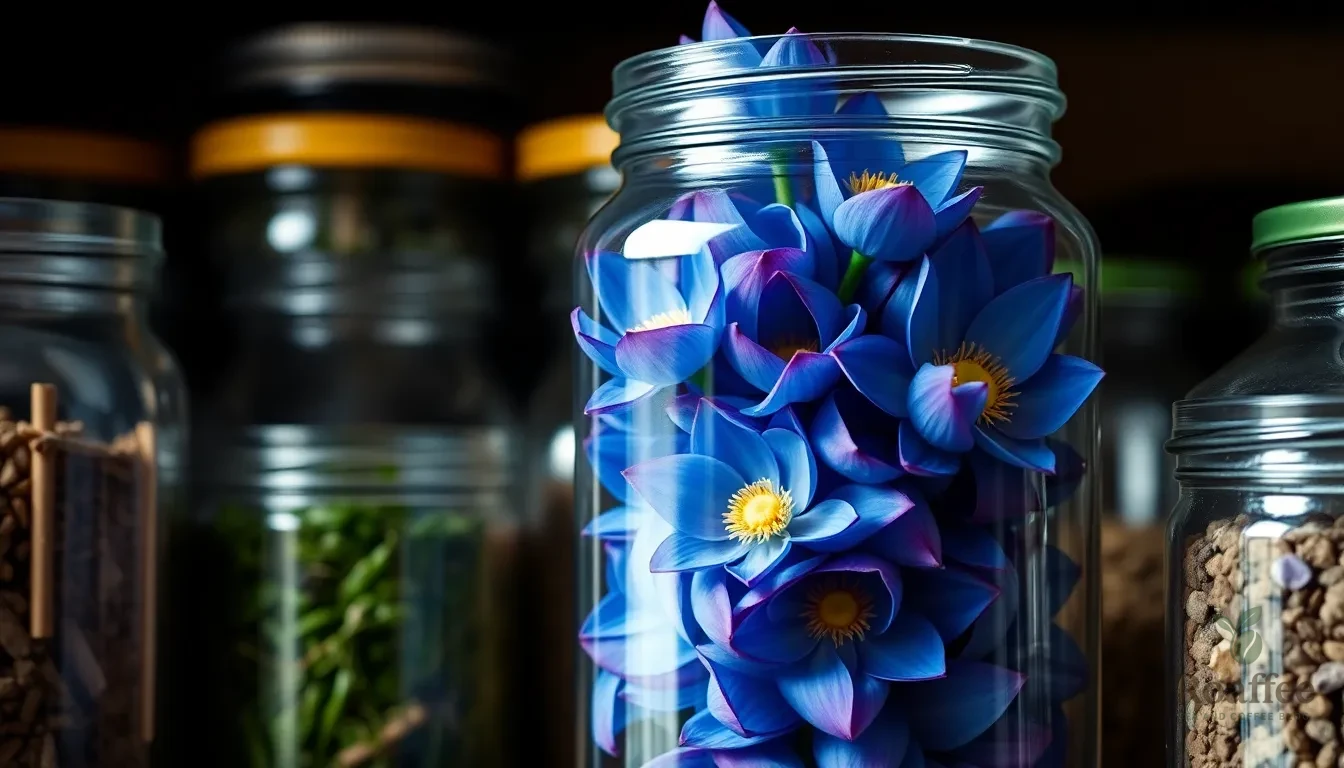
Proper storage ensures our blue lotus flowers maintain their potency and delicate flavor for months to come. We recommend storing dried blue lotus flowers in a clean airtight container immediately after purchase to preserve their freshness and therapeutic compounds.
Optimal Storage Conditions
We store our blue lotus flowers in a cool dark place away from direct sunlight and moisture. Heat and light can degrade the beneficial compounds like nuciferine and aporphine that give blue lotus tea its calming effects. A pantry cupboard or kitchen cabinet works perfectly for maintaining the ideal storage environment.
Container Selection
Glass jars with tight fitting lids provide the best protection for our dried blue lotus petals. We avoid plastic containers as they can absorb the flowers’ natural oils and compromise the flavor over time. Metal tins with secure seals also work well for preserving the delicate floral aroma we love in our tea.
Freshness Indicators
Quality blue lotus flowers should maintain their vibrant color and pleasant fragrance when stored properly. We check our stored flowers periodically for any signs of moisture or mold which indicate the need for replacement. Fresh dried blue lotus flowers typically retain their potency for 12 to 18 months when stored correctly.
Special Storage for Infusions
When we prepare blue lotus alcohol infusions we use dark glass jars to protect the mixture from light exposure. We seal these jars tightly and store them in a cool dark place for 2 to 4 weeks. Shaking the jar occasionally during this period enhances the extraction process and creates a more potent final product.
Temperature Considerations
We maintain storage temperatures between 60°F and 70°F (15°C to 21°C) for optimal preservation. Extreme temperature fluctuations can cause condensation inside storage containers which leads to moisture damage. Consistent cool temperatures help preserve both the visual appeal and therapeutic benefits of our blue lotus flowers.
Serving Suggestions
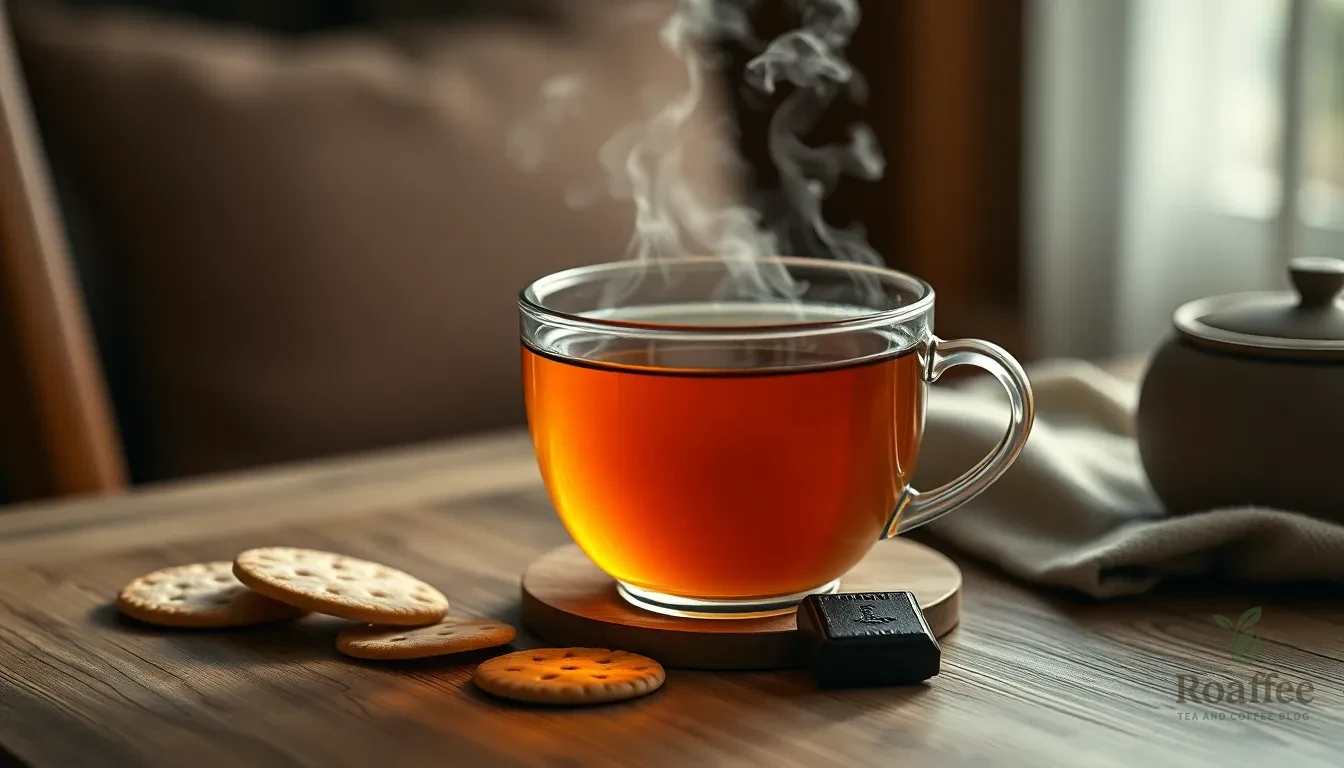
We recommend serving blue lotus tea while it’s hot in your favorite mug to fully appreciate its softly sweet, floral flavor with subtle earthiness. The optimal serving temperature allows the delicate compounds to release their full aromatic potential.
Temperature and Timing Guidelines:
| Serving Method | Temperature | Optimal Time |
|---|---|---|
| Hot Service | 160-180°F | Immediately after brewing |
| Warm Service | 140-160°F | Within 15 minutes |
| Room Temperature | 70-80°F | Within 30 minutes |
Our preferred serving approach involves pouring the freshly strained tea into a ceramic or glass mug that retains heat effectively. Glass vessels particularly enhance the visual experience as you watch the golden amber liquid swirl gently in the cup.
Creating the Perfect Ambiance
We suggest sipping blue lotus tea slowly in a quiet setting to fully appreciate both its taste and tranquilizing effects. The peaceful, delicate floral bouquet emerges most prominently when you take time to inhale the aroma before each sip.
Transform your tea time into a mindful ritual by dimming the lights and removing distractions. Many of our readers find that blue lotus tea pairs beautifully with meditation practices or evening wind-down routines.
Improving Your Blue Lotus Experience
Sweetening options can elevate the natural floral notes without overwhelming the delicate flavor profile. We recommend starting with a small amount of honey, which complements the tea’s earthiness while maintaining its therapeutic properties.
Consider serving blue lotus tea alongside light snacks that won’t compete with its subtle flavors. Plain crackers, vanilla wafers, or a small piece of dark chocolate can provide gentle accompaniment without masking the tea’s unique characteristics.
Seasonal Serving Variations
During warmer months, we suggest allowing the tea to cool slightly before serving, creating a more refreshing experience while preserving the floral essence. Winter evenings call for serving the tea at its hottest temperature, adding an extra layer of comfort to your relaxation routine.
The sensory experience of blue lotus tea invokes the scent and feel of a blooming garden, making it perfect for creating a spa-like atmosphere in your own home. We find that the combination of its visual appeal, gentle aroma, and soothing effects makes each cup a complete sensory journey.
Safety Considerations
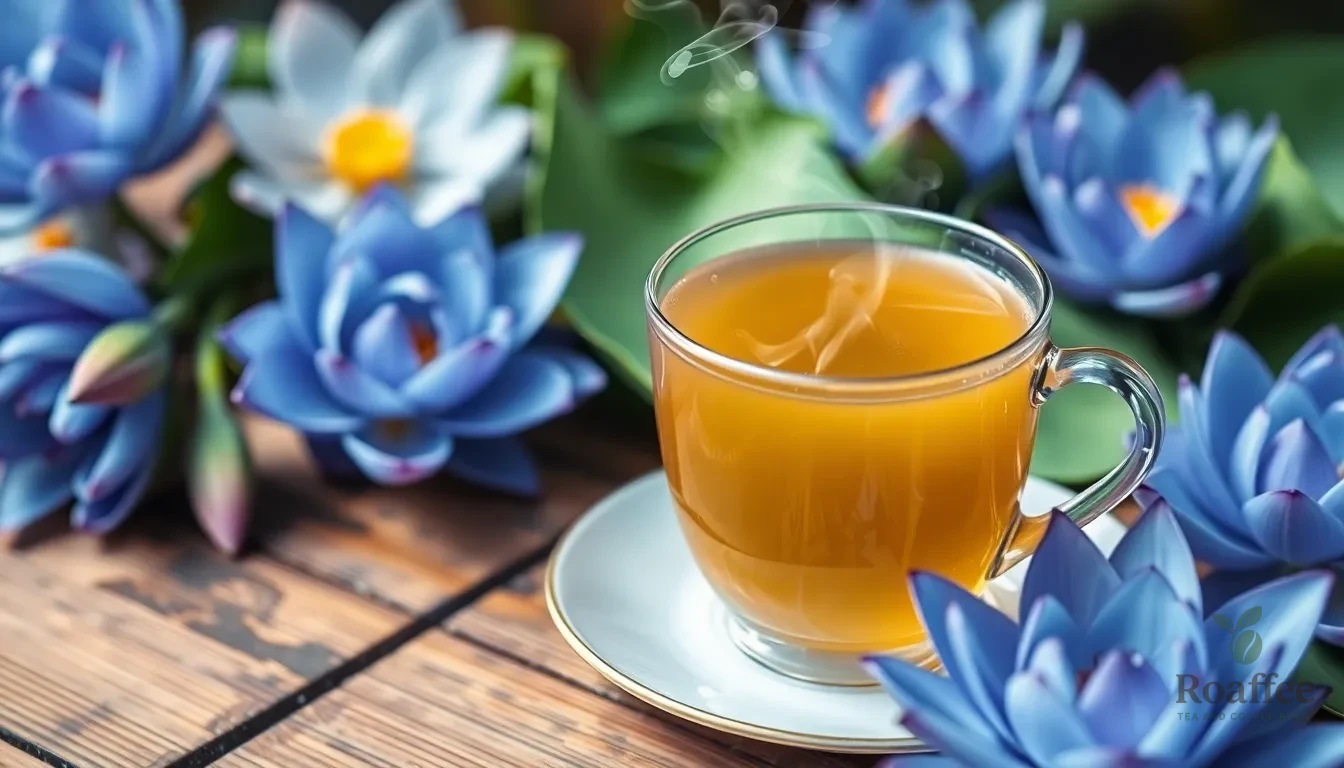
While we appreciate blue lotus tea for its calming properties and gentle flavor, understanding its potential effects ensures we can enjoy this ancient beverage responsibly. The tea may cause drowsiness and dizziness, particularly when consumed in higher doses, which makes it important to start with smaller amounts and gradually increase based on our individual tolerance levels.
Potential Side Effects
Blue lotus tea can produce several effects that we should be aware of before incorporating it into our wellness routine. Drowsiness represents the most common side effect, which aligns with the tea’s traditional use as a sleep aid and relaxation promoter. Dizziness may also occur, especially when we consume larger quantities than our body is accustomed to processing.
More important concerns arise when we consume large amounts of blue lotus tea. Hallucinogenic effects have been reported with excessive consumption, though these typically occur only at doses far exceeding normal tea preparation amounts. Allergic reactions, while rare, can manifest as skin irritation, swelling, or breathing difficulties in sensitive individuals.
Usage Precautions
We recommend avoiding activities that require full attention, such as driving or operating machinery, after consuming blue lotus tea until we understand how it affects our individual system. The tea’s relaxing properties can impair our alertness and reaction time, making these precautions essential for our safety.
Pregnant or breastfeeding individuals should consult healthcare providers before using blue lotus tea, as limited research exists about its safety during these periods. Those with existing medical conditions or taking medications should also seek professional guidance to avoid potential interactions.
Safety Assessment Data
| Safety Parameter | Assessment Result |
|---|---|
| Genotoxicity | No adverse effects observed |
| Reproductive Toxicity | Minimal risk at typical consumption levels |
| Skin Irritation | Low incidence rate |
| Overall Safety Profile | Generally safe when used appropriately |
Scientific safety assessments based on toxicology data, historical use patterns, and comprehensive reviews of plant constituents indicate that blue lotus extracts pose minimal risk when consumed in typical amounts. These evaluations examined multiple endpoints including genotoxicity, reproductive toxicity, and skin irritation potential.
Responsible Consumption Guidelines
Starting with small amounts allows us to gauge our individual response before increasing our intake. We suggest beginning with half the recommended serving size and monitoring our body’s reaction over several uses. This approach helps us identify our optimal dosage while minimizing the risk of unwanted effects.
Understanding these safety considerations empowers us to enjoy blue lotus tea as part of our wellness routine while maintaining awareness of its potential effects and contraindications.
Conclusion
Blue lotus tea offers us a wonderful gateway into the ancient industry of herbal wellness while providing modern-day benefits we can all appreciate. We’ve explored how this remarkable flower transforms into a soothing beverage that supports relaxation and enhances our evening routines.
The beauty of blue lotus tea lies in its versatility – whether we prefer hot brewing cold steeping or sun tea methods we can customize our experience to match our mood and preferences. With proper storage and mindful preparation we’re able to preserve the tea’s delicate qualities and maximize its therapeutic potential.
As we incorporate blue lotus tea into our wellness routines we’re connecting with centuries of traditional wisdom while enjoying a caffeine-free alternative that promotes tranquility and restful sleep. We encourage you to start your blue lotus journey slowly and discover how this ancient flower can enhance your modern lifestyle.
Frequently Asked Questions
What is blue lotus tea?
Blue lotus tea is a caffeine-free herbal beverage made from the dried petals and buds of the Nymphaea caerulea flower. This sacred flower has been cherished for over 3,000 years, particularly in ancient Egypt, for its calming and therapeutic properties. The tea offers a subtle floral flavor with earthy undertones and natural sweetness.
What are the health benefits of blue lotus tea?
Blue lotus tea promotes relaxation and stress relief, acts as a natural mood elevator, and improves sleep quality. It contains antioxidants that protect against oxidative stress and inflammation. The tea also supports digestive health by relaxing the digestive tract and may offer neuroprotective effects that support cognitive function and mental clarity.
How do you brew blue lotus tea?
To brew blue lotus tea, use 1-2 tablespoons of dried flowers per cup. Heat water to 200°F (93°C) without boiling. Steep the flowers for 5-15 minutes depending on desired strength. Strain and serve hot. You can add honey, lemon, or other herbs to enhance the flavor according to your preference.
Is blue lotus tea safe to drink?
Blue lotus tea is generally safe when consumed in typical amounts. However, it may cause drowsiness and dizziness, especially in higher doses. Start with smaller amounts to gauge tolerance. Pregnant or breastfeeding individuals should consult healthcare providers before use. Avoid activities requiring full attention after consumption.
When is the best time to drink blue lotus tea?
Blue lotus tea is ideal for evening consumption due to its caffeine-free nature and calming effects. It’s perfect for bedtime rituals, meditation, or when you need to unwind after a stressful day. The tea promotes restful sleep without disrupting natural sleep patterns, making it an excellent nighttime beverage choice.
How should I store blue lotus flowers?
Store dried blue lotus flowers in a clean, airtight container in a cool, dark place away from direct sunlight and moisture. Glass jars with tight-fitting lids are preferred, though metal tins also work well. Proper storage maintains potency and preserves the delicate floral flavors of the tea.
Can I mix blue lotus tea with other herbs?
Yes, blue lotus tea blends well with various herbs. Popular combinations include chamomile for enhanced relaxation, mint for a refreshing twist, lemon for citrus notes, and green tea for added antioxidants. You can also add spices like cinnamon, cardamom, or ginger to create personalized blends for different moods and occasions.
What does blue lotus tea taste like?
Blue lotus tea has a unique flavor profile that is subtly floral with earthy undertones and a hint of natural sweetness. The taste is gentle and pleasant, providing a soothing drinking experience. The delicate floral notes make it appealing to those who enjoy herbal teas with mild, sophisticated flavors.

